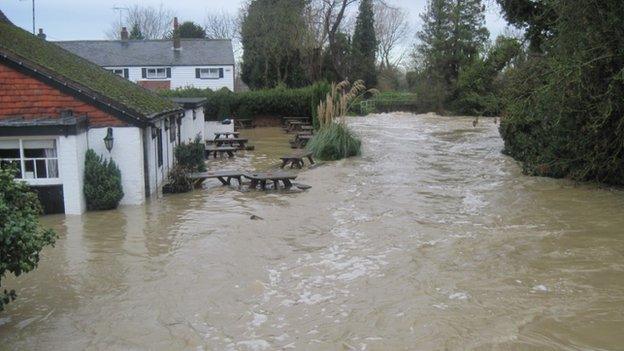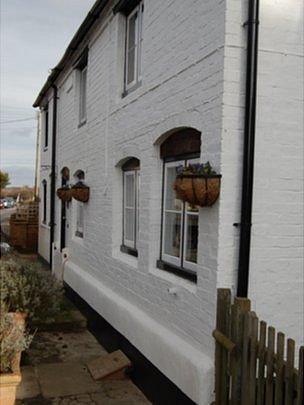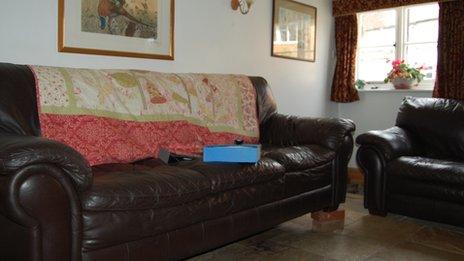UK floods: How one woman held back the water
- Published

East Peckham was hit twice by floods at Christmas - by the River Bourne and run-off rainwater on Christmas Eve and then the River Medway on Christmas Day
A woman whose house was flooded four times in 14 months has managed to hold back the water in this year's devastating floods after she took action to protect her home. But could more homeowners take similar steps?
East Peckham was hit twice in two days over Christmas.
Water from the River Bourne flooded the Kent village on Christmas Eve along with rain running off nearby fields - and then the River Medway burst its banks on Christmas Day.
Sue Chalkley was faced with flood water 18in (45cm) deep outside her house but ended up with only an inch (2.5cm) inside, because resilience measures built into her property after floods in the 1990s kept most of it out.
Cars were left floating in other parts of the village.
Submersible pump
And, faced with the rising water in Snoll Hatch Road, Mrs Chalkley and her family knew flood gates and flood boards would slow the water enough for them to raise furniture on to bricks before it got into the house.
She said when the water did ooze into their home, they immediately swept it into a pit that contains a submersible pump in their living room.
A gully inside the house also took water from a drain near the front door straight to the pit, and from there it was pumped back outside again.
"It was the best flood I've ever had," Mrs Chalkley said. "Everything was working."
They had faced a vastly different situation in 1998, when their house was flooded three times in October with water pouring in through the front and back doors.
Mrs Chalkley said they had known the house was at risk when they moved in, because the property had been hit by the massive floods of 1968.

The pump removed the flood water from inside the house and sent it back out via a pipe in the wall
"We thought once in 30 years would be bearable," she said. "Well, we thought that, but we had never been flooded before."
In 1998, after the family had cleaned up a third time, insurers moved them into temporary accommodation and began rebuilding the house.
Flood water subsided in two weeks but it took three months for the property to dry out.
Builders brought in polythene and industrial dryers, before they removed the floors, kitchen and electrics, and all the plaster from the walls.
The family returned to their home in July 1999, after a nine-month wait. But that December, the house was swamped again.
"I remember I just broke down," Mrs Chalkley said. "The second time was when I said I would do anything not to have this happen again."
As the family faced another rebuild and their second £60,000 insurance claim in two years, Mrs Chalkley talked to insurers and builders about adding flood resilience measures.
'Gives us time'
Repairs paid for by insurers included moving electrical cables so they came down the walls instead of under the floor, and refitting stone floors with waterproof grouting.
The family paid extra to fit frames with flood gates at the front and flood boards at the back, tanking (a waterproofing method) around the outside of the house, a pump and gully inside the house, and a generator in the conservatory.
They also raised the threshold at the back of the house during later extension work.

Sue Chalkley talked to builders and insurers about adding flood resilience to her home after the property had to be rebuilt a second time

A pump in the corner of her living room floor sends water back outside through a pipe higher up the wall

The family used to raise furniture on "a tower" of bricks but now they use one or two bricks because only one or two inches of water comes in

There are no electrical cables under the floor - they come down the walls to raised plug sockets
"We didn't aim to make it perfectly dry," Mrs Chalkley said. "Our aim was to keep the water to one or two inches."
"It's all about slowing the water," she added. "It gives us time to get the bricks, move the furniture, move the car."
The family carried out their flood resilience work about 15 years ago, but Mrs Chalkley, a former trustee of the National Flood Forum and chairwoman of East Peckham flood group, believes most people could take similar measures for under £2,000.
This time, she will not be making an insurance claim for her house or its contents, but there may be some redecorating after paint bubbled up near the skirting boards.
She believes the measures she took would work in the majority of floods but not the most severe - where specialist advice would be needed.
'National campaign needed'
Since the beginning of December, about 5,800 properties have been flooded across England after the country faced its wettest January since 1766.
Thousands of people face a clean-up operation that could take several months.
The government has offered a £5,000 "repair and renew, external" grant for flood-hit homeowners and businesses.
In East Peckham, the flood group will hold a "flood fair" in April when suppliers of resilience equipment will set up stalls.
Mrs Chalkley said there was real enthusiasm for the event in the village, and has also called for a national campaign to encourage homeowners to build flood protection measures.
"I do feel quite evangelical about it. We are experienced 'floodies' now," she said.
- Published5 February 2014
- Published22 January 2014
- Published4 January 2014
- Published30 December 2013